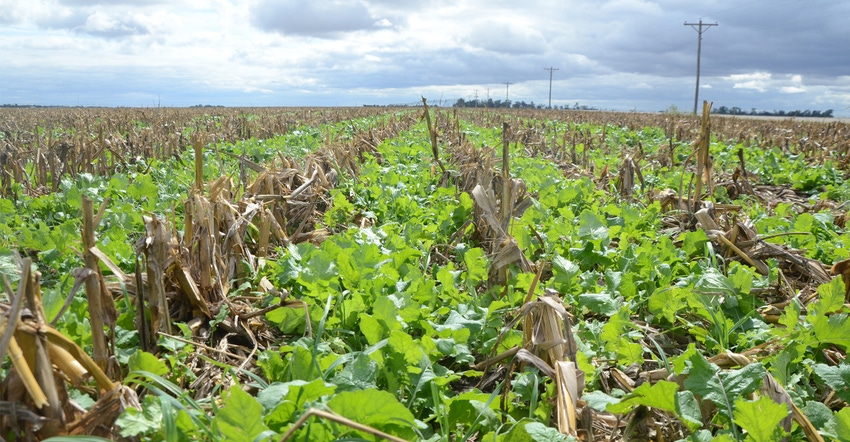
I have written quite a bit about water management — not just with respect to irrigation, but also how soil health and residue play a role in the water balance. In some cases, this means managing evapotranspiration, or ET.
At a recent Cover Crops Management Day in Columbus, Neb., Dwayne Beck, soil health and cover crop expert and manager of the Dakota Lakes Research Farm, emphasized a key point surrounding cover crops and water holding capacity: "Take the 'E' out of ET."
In previous Resilient Ag Landscapes columns, I've touched on how having taller residue prevents undesirable evaporative water losses — what Beck refers to as "the water that makes no money." Nebraska numbers suggest in a typical silt loam soil, tillage can mean a loss of half to three-quarters of an inch of soil water with each tillage trip.
Most of the examples I've previously talked about involved wheat residue — and while leaving tall wheat residue by harvesting with a stripper head is a big part of the residue management at Dakota Lakes, Beck outlined other ways no-till and a diverse rotation help take the "E" out of ET.
"'T' is where you put the water through a plant, where you're making money," Beck says. "That's what you do with cover crops. You use it to catch nutrients, compete with weeds."
Residue aside, one of the biggest factors affecting water in a no-till scenario is organic matter, which Beck notes, "tells you more about soil than almost anything else."
With 1% organic matter, Beck notes that the soil can hold 0.26 inches of water in the top 6 inches. When organic matter increases to 4%, the soil can hold 1.4 inches in the top 6 inches of soil – or 2 inches of water in the top 12 inches.
Within all texture groups, when organic matter increases from 1% to 3%, available water holding capacity approximately doubles. When organic matter increases to 4%, it then accounts for more than 60% of available water holding capacity.
Over the nearly 20 years that Dakota Lakes has been 100% no-till, the farm has seen significant improvements in water holding capacity — thanks to the adoption of no-till and diverse rotations that include small grains with abundant residue such as winter wheat, and cover crops and forage crops.
One of the objectives at Dakota Lakes Research Farm — and one of the first goals since the research farm was established — is mimicking the native prairie and how the native prairie handles intense rain events, Beck says. Through years of cover cropping, grazing and no-till, with greater water infiltration and higher organic matter, that goal is now closer to being realized.
"If you get 2 inches of water on a native prairie and you walk out, you don't sink in," Beck says.
Beck makes note of one center pivot-irrigated field at Dakota Lakes where 2 inches of water can be applied in nine minutes without any runoff.
"If you come and visit us in the summertime, we'll have an irrigator running, and we'll walk you behind the irrigator after we put on 2 inches of water and you will not get your feet muddy,” he says.
But the other side of "taking the 'E' out of ET" pertains to putting that water to more desirable or profitable use – such as cover crops, which not only hold the soil but in the long term improve infiltration and water holding capacity.
This can, at times, involve a shift in mindset. Beck notes that in spring most farmers are more concerned about keeping moisture out of the soil, keeping it dry enough to plant.
"Instead of just focusing on having it dry during the wet part of the year, focus on having the soil cool during the hot part of the year, because roots don't function well when they're hot," he says.
When soil is compacted and lacks the infiltration that comes from a diverse rotation, living root system and earthworm channels, water gets trapped on the soil surface, where it evaporates.
"Maximize water use in late summer,” Beck says. “You make the water go into the soil, and not get it trapped up at the top. If you make it go down that hole, it goes down that hole, soaks in along the edge of that hole all the way down, finds a dry spot and soaks in. It's further away from the surface. And if you have that armor on the soil the whole time, you reduce evaporation."
About the Author(s)
You May Also Like






